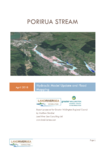Porirua Stream Hydraulic Model Update and Flood Mapping
Search in document library
Purpose of the Report
To update the Porirua Stream hydraulic model using new hydrology data, rerun flood scenarios, and produce updated flood maps including climate change effects.
Geographic Area Covered
The report covers the Porirua Stream catchment in the Wellington region, New Zealand, including its main tributaries and the area draining into Porirua Harbour.
Summary
This report provides an updated assessment of flood risks for the Porirua Stream catchment, based on new hydrology data and improved modelling techniques. The update was commissioned by Greater Wellington Regional Council and carried out by Land River Sea Consulting Ltd. The Porirua Stream catchment, located north of Wellington City, includes several main tributaries and drains into Porirua Harbour.
The main purpose of the update was to incorporate new rainfall and flow data, as well as to account for the potential impacts of climate change on flood levels. The model was adjusted to reflect recent hydrology studies, and flood scenarios were rerun to produce new flood maps for a 100-year flood event, both with and without climate change effects.
The modelling found that, under current conditions, the peak flow for a 100-year flood event is estimated at 130 cubic metres per second. With climate change (allowing for a 20% increase in peak rainfall), this increases to 170 cubic metres per second. The model also considered the effects of sea level rise and storm surges at the downstream boundary, as well as the potential for culvert and bridge blockages during flood events.
To ensure the results are robust, the model included a 'freeboard'—an extra allowance for uncertainties such as measurement errors, variations in land surface data, and the unpredictable effects of debris or blockages. This freeboard was set at 0.3 metres above the highest modelled flood level.
The updated flood maps show the areas at risk of flooding during a 100-year event, including the additional effects of climate change. These maps identify both the depth of flooding and areas that are particularly sensitive to flooding. The results indicate that flood extents have changed in some locations compared to previous modelling from 2012, reflecting the improved data and updated methods.
The report also examined the impact of potential blockages at key bridges and culverts, finding that such blockages can significantly increase local flood depths and extents. These scenarios were included in the flood-sensitive area mapping.
Limitations of the study include limited calibration data and some uncertainty in the land surface and cross-section measurements. The report recommends that these uncertainties be considered when using the flood maps for planning or development decisions.
In summary, the updated modelling provides a more accurate and up-to-date picture of flood risks in the Porirua Stream catchment, taking into account new data and the likely effects of climate change. The results are intended to support flood risk management, land use planning, and community safety in the area.
